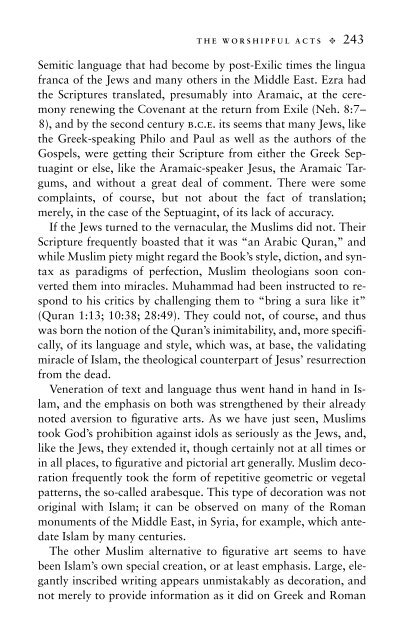Islam: A Guide for Jews and Christians - Electric Scotland
Islam: A Guide for Jews and Christians - Electric Scotland
Islam: A Guide for Jews and Christians - Electric Scotland
Create successful ePaper yourself
Turn your PDF publications into a flip-book with our unique Google optimized e-Paper software.
THE WORSHIPFUL ACTS t 243<br />
Semitic language that had become by post-Exilic times the lingua<br />
franca of the <strong>Jews</strong> <strong>and</strong> many others in the Middle East. Ezra had<br />
the Scriptures translated, presumably into Aramaic, at the ceremony<br />
renewing the Covenant at the return from Exile (Neh. 8:7–<br />
8), <strong>and</strong> by the second century b.c.e. its seems that many <strong>Jews</strong>, like<br />
the Greek-speaking Philo <strong>and</strong> Paul as well as the authors of the<br />
Gospels, were getting their Scripture from either the Greek Septuagint<br />
or else, like the Aramaic-speaker Jesus, the Aramaic Targums,<br />
<strong>and</strong> without a great deal of comment. There were some<br />
complaints, of course, but not about the fact of translation;<br />
merely, in the case of the Septuagint, of its lack of accuracy.<br />
If the <strong>Jews</strong> turned to the vernacular, the Muslims did not. Their<br />
Scripture frequently boasted that it was “an Arabic Quran,” <strong>and</strong><br />
while Muslim piety might regard the Book’s style, diction, <strong>and</strong> syntax<br />
as paradigms of perfection, Muslim theologians soon converted<br />
them into miracles. Muhammad had been instructed to respond<br />
to his critics by challenging them to “bring a sura like it”<br />
(Quran 1:13; 10:38; 28:49). They could not, of course, <strong>and</strong> thus<br />
was born the notion of the Quran’s inimitability, <strong>and</strong>, more specifically,<br />
of its language <strong>and</strong> style, which was, at base, the validating<br />
miracle of <strong>Islam</strong>, the theological counterpart of Jesus’ resurrection<br />
from the dead.<br />
Veneration of text <strong>and</strong> language thus went h<strong>and</strong> in h<strong>and</strong> in <strong>Islam</strong>,<br />
<strong>and</strong> the emphasis on both was strengthened by their already<br />
noted aversion to figurative arts. As we have just seen, Muslims<br />
took God’s prohibition against idols as seriously as the <strong>Jews</strong>, <strong>and</strong>,<br />
like the <strong>Jews</strong>, they extended it, though certainly not at all times or<br />
in all places, to figurative <strong>and</strong> pictorial art generally. Muslim decoration<br />
frequently took the <strong>for</strong>m of repetitive geometric or vegetal<br />
patterns, the so-called arabesque. This type of decoration was not<br />
original with <strong>Islam</strong>; it can be observed on many of the Roman<br />
monuments of the Middle East, in Syria, <strong>for</strong> example, which antedate<br />
<strong>Islam</strong> by many centuries.<br />
The other Muslim alternative to figurative art seems to have<br />
been <strong>Islam</strong>’s own special creation, or at least emphasis. Large, elegantly<br />
inscribed writing appears unmistakably as decoration, <strong>and</strong><br />
not merely to provide in<strong>for</strong>mation as it did on Greek <strong>and</strong> Roman
















